You can figure out your child’s reading level at home yourself with a casual assessment called a running record. Elementary school teachers frequently use running records to spot-check student progress quickly throughout the year. You can even download a free simple running record form here to get started and I’ll walk you step-by-step through the process!
A running record can be a really helpful tool for determining your child’s reading level. And the best part is you can do a running record on any kid with almost any book within 10 minutes!
How to Use a Running Record
First, choose a book that you think your child can read independently. Count the words. If it is a longer book, you can choose an excerpt around 100 words long.
Next, sit beside your child as he reads aloud.
Then, on your running record form, write the page number in the left column and put a check mark for each word read correctly on that page. Each page gets a new row.

Marking Errors on a Running Record
When your child misreads a word, quickly write the mistake over a small line and write the correct word under the line. If the child goes back and self corrects the word, write SC over the top. Don’t count it as an error on the running record form if the child self corrects.
Other common reading errors can be recorded like this:
T have to tell the child the word
^ extra word inserted
— word skipped
When the child has finished reading the book, use the errors column on the running record form to tally up mistakes. Count one error for every word misread, skipped, inserted, or told.
Remember, if the child makes a mistake but then self-corrects, you don’t count that as an error. You also don’t count an error if the child repeats a word or phrase.

Scoring a Running Record
Scoring a running record is a quick two-step process.
First, subtract the number of errors from the total number of words in the text. For example, in the book excerpt above, there are 103 words and the child made 6 errors, so his score is 97.
Second, determine accuracy by dividing the score by the total number of words. For example, you just divide 97 by the word total 103 to get a 94% accuracy rate. Yay! That means this book is just right as an instructional book for this student!
READ: Kindergarten Readiness Checklist & Assessment for Preschool & Pre-K
Understanding a Running Record
Here’s how to interpret the running record score:
95-100% EASY (This is a good level for the child to read independently.)
90-94% INSTRUCTIONAL (This is the right level for teacher & child to work on together!)
Below 90% HARD (Wait on this one! Too tough for now.)
Ideally, you want your child to be challenged in a gentle way, so books where he can read 90-94% of words correctly and independently are the perfect fit for learning! With this ratio, the teacher or parent can help the student learn new concepts and extend learning without the child becoming discouraged or frustrated.
In school settings, teachers choose guided reading books within the instructional 90-94% level to drive instruction. At home, parents can do the same by carefully choosing leveled books, which might not be as difficult as you think. You can also use these reading level charts with suggested books by grade level. Once you know your child’s level, you can choose books more easily! For quick book ideas, check out the following books lists by grade level:
- 1st Grade Books List
- 2nd Grade Books List
- 3rd Grade Books List
- 4th Grade Books List
- 5th Grade Books List
- 6th Grade Books List

Going Deeper on the Running Record
In the last columns of the running record, there are three columns: Meaning, Structure, and Visual. These are optional and may be skipped completely, however they do offer some invaluable insight to the teacher about the types of errors your student is committing.
Running Record Meaning Cues: Does it make sense?
Meaning cues are about whether what you just read makes sense. Does it have meaning in the text? For example, if the child reads, “Hull, Hen!” and then looks confused, the child is correctly understanding that what she just read didn’t make sense. In the example above, the child uses this as a cue to go back and self-correct the sentence, “Hello, Hen!” and nods to herself to show that the new reading makes more sense. Good readers constantly read the text for meaning!
Running Record Structure Cues: Does it sound right?
Structure cues are also sometimes called syntax cues because they indicate errors in the grammar and structure of the language. As the student is reading, they notice that the text didn’t sound right and may go back to re-read and self correct.
Running Record Visual Cues: Does it look right?
Visual cues are when a child uses information they see such as the beginning and ends of the words to analyze new words based on how they look. An example of a visual cue error on a running record would be if the student read, “Chicken!” instead of “Hen!” This indicates that the child completely missed the visual cue of the word size and letters and instead was relying on prior knowledge based on the illustration.

Don’t toss the easy books!
So the absolute best guided reading instruction can occur when a child confidently can read 90-94% of a book! After utilizing a running record, the teacher and parents can then hone in specifically on the error types the student is making most commonly as areas of growth and acceleration. If your child is struggling significantly to learn simple site words or even to memorize the letter sounds and blends, it may be time to consider dyslexia.
However, there is great value in reading or rereading books that are easy, too! While they might not challenge with new information, easy books allow a child to practice and review skills previously learned independently with great success. And we all know how vital practice is to mastering any subject! What does Mom always say? “Practice makes perfect!” Easy books help kids fall in love with reading!
For this reason, whether in a classroom or home setting, it is a fabulous idea for teachers and parents to keep a box of easy, previously read books for students to reread. Even 10-15 minutes a day of independent reading, silently or out loud to a family members or pet (or teddy bear) can significantly increase a child’s reading fluency, confidence, and comprehension.
Grab your free running record download now and get started!


Pingback: Stop! Do You Know Your Kid's Reading Level? - Maestra Mom
I haven’t heard of a running record before..sounds like a great tool for reading.